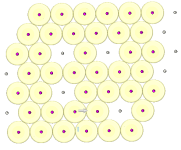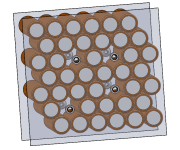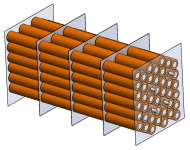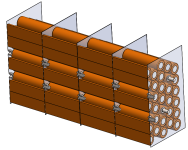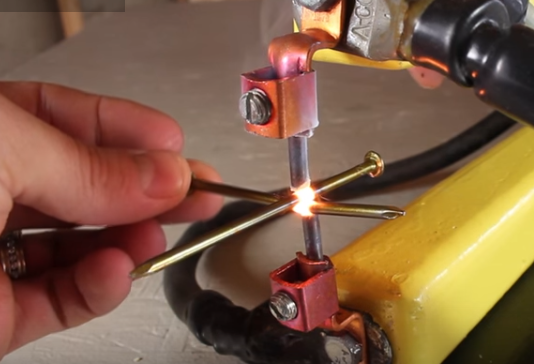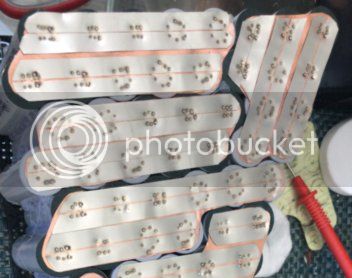I think you're on the right track, and also that there are some potential pitfalls.
Automation is a great way to avoid being able to compensate for things and so really gets you thinking about how to control the material and environment. This can be a good thing but takes more work designing the material feed rather than welding. Humans are amazingly adaptable which is a pain when automating.
If you have varying flatness, then putting constant joules through the workpiece may help but may not compensate enough. If the flatness is a problem, the resistance path may be longer rather than going straight through as a spot, the solution might be to press harder, have a pointier tip to the probe or put more joules in but the K-weld can only see a greater resistance so it puts a bit more duration in to the weld to compensate, but this won't be enough if the hot spot between copper and cell is 1mm off to the side and so the weld area is twice as big - it may need to put double the joules in, to get the right level of weld, but then you'd have a weld that put twice as much heat into your cell which you might not want.
The right way is to prevent the non flat piece of strip getting in to the process in the first place which is easy for machines to achieve but more difficult with tin snips.
It would be nice to get it to work without constant joules and then switch that on later...
So, steppers are cheaper and easier to control than servos and this probably isn't a dynamic application other than Z so you don't necessarily need servos.
Thinking a little old school due to budget, for a relatively simple method, an XY table with a Z axis using a pneumatic cylinder would give you accurate XY position but constant (or controllable) force without accurate Z position which may be better - the constant force compensates for some metal strip flex, tool wear etc so you get better pressure control than a servo for less cost. A Servo on the Z might give you force control at $700 but not sure how good it would be or needs to be.
A typical
industrial servo, controller and actuator of this sort of size would be of the order of £2k (thinking Bosch Rexroth, SMC or or Festo eg ESBF-BS-32-100-10P or https://www.smc.eu/portal_ssl/WebContent/digital_catalog_2/jsp/view_descriptions.jsp?dc_product_id=164441 ) of course there are a number of other ways (distance compressing a spring for example) to achieve this. I am not suggesting you lay out 20K on automation hardware, just that there will be limits to the rigidity and precision of an cheap chinese system that has pros and cons. You might on the other hand be talking about building your own from motors, arduino controllers and some good old machined bearings and slides etc in which case a few weeks work will get you something really robust for $700 but there's a whole new thread in that build

Assuming a relatively simple bought in table, I'd spend more time designing tooling and fixturing than on the XYZ table - the repeatability of holding the bank of batteries flat provides the surface that you bond your flat piece of copper to. The spacing determines where the probe hits on the battery. The way you hold the copper and Nickel determine the relative position (you don't want to weld on the edge all the way along and puncture the centre row of a bank of 40).
An alternative configuration is an XY table moving the cells and a Z axis for weld heads - it will be easier if you don't have to move the welder in X&Y
A nice thing about starting with virgin material and lasering is that dimensions and flatness will probably be good which will help with contol and repeatability.
I've been assuming you're using the table open loop but if you want closed loop control you could do a lot with electrical contact from the tip. If that's the case I might agree on servos or three steppers and a spring on Z. Clever control can more than compensate for quality hardware but you need to be a programmer or control systems chap rather than machinist type of engineer.
System might then detect the position of the battery and position of the strip as touching the metal with the probe gives a signal which in the first instance tells you where the cell is if you laser some alignment holes in the sheet
This allows you to offset your welds so that they are in the right place on the cell. It allows you to measure the cell position (in case your glueing is out at 4AM) and compensate for X,Y or even Z misalignment which might involve bending the plate further in.
Next leve up in complexity - you could probably measure resistance and detect when the probe hits the nickel and when the nickel hits the copper though copper to cell might be tricky due to lower resistance. This might give you force compensation for material flatness. The first level of flatness compensation might be drive downward till second contact then apply 10N more force (2.2 lbf). The next level might be battery is 0.5mm offset so I have to bend the nickel to compensate so due to battery offset my force is contact plus 20N instead of 10 etc etc
The best control is to ensure that the variation in the material feeding in to the process is correct so you don't have to compensate. It's much easier to keep the metal flat than to work out how to flatten it or compensate for bent bits.
This means going back through the process to the previous step. Once all cells are identical, in a perfect array, everything is in exactly the same position etc the end process needs much less control.
Thermal control is relatively simple - heat it with a thermostat, stick a sensor somewhere relevant - perhaps a K type on the probe (electrically insulated) and blow hot air, stick it next to a nichrome wire heater, wrap in silicone covered nichrome or as you say, preheat - maybe on a copper block for tungston so the preheat is in the tips rather than the block.
Another thing I've thought might be worth doing is a comressed air jet to cool the weld directly after welding. Easy with automation, offset it by one cell and move to next cell immediately - you can cool the previous weld as you weld the next. Reduce cell damage from heat.
You should use a nozzle but it can be a simple one. this is where all the expansion occurs (so you cool the workpiece not the pipe) and use a direct nozzle not a venturi (used for cleaning - higher flow but not as good at cooling). You could also use this to cool the tips if needed so your temperature control was active cooling rather than active heating but inefficient as you're trying to get heat into the weld so hot tips are probably a good starting point.
Reckon the simplest would be an XY table with a, pneumatic Z axis, jigs to hold the bits in the right place and lasered bits so they're right in the first place.


